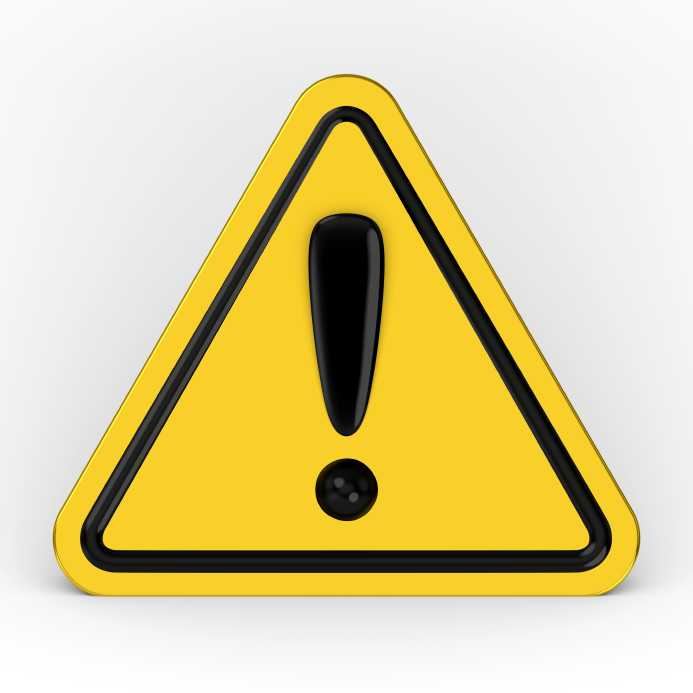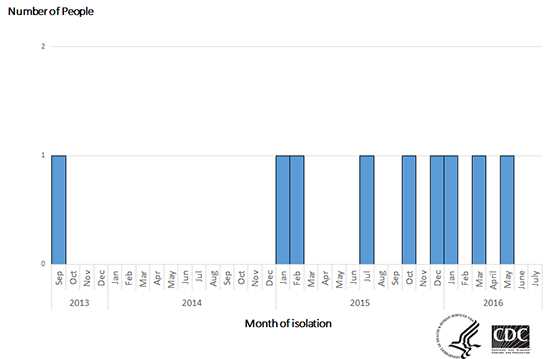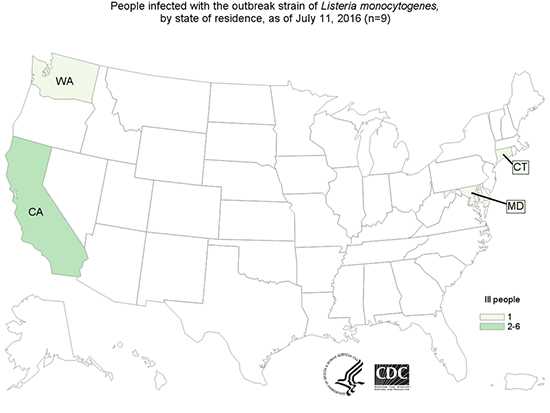Multistate Outbreak of Listeriosis Linked to Frozen Vegetables (Final Update)
Posted July 15, 2016 1:45 PM ET
This outbreak investigation is over. However, people could continue to get sick because recalled products may still be in freezers and people who don’t know about the recalls could eat them. Retailers should not sell and consumers should not eat recalled products. Read the Recall and Advice to Consumers and Retailers.
Highlights
- This outbreak investigation is over. However, people could continue to get sick because recalled products may still be freezers and people who don’t know about the recalls could eat them. Retailers should not sell and consumers should not eat recalled products. Read the Recall and Advice to Consumers and Retailers.
- CDC, several states, and the U.S. Food and Drug Administration (FDA) investigated a multistate outbreak of Listeria monocytogenes infections (listeriosis).
- Listeria can cause a serious, life-threatening illness.
- Nine people infected with the outbreak strains of Listeria have been reported from four states since September 13, 2013.
- All nine people were hospitalized, and three of them died. Listeriosis was considered to be a cause of death for one person in Connecticut. For the two deaths in Maryland and Washington, listeriosis was not considered to be a cause of death.
- Epidemiologic and laboratory evidence indicated that frozen vegetables produced by CRF Frozen Foods of Pasco, Washington and sold under various brand names were a likely source of illness in this outbreak.
- On April 23, 2016, CRF Frozen Foods recalled 11 frozen vegetable products because of potential Listeria contamination.
- On May 2, 2016, CRF Frozen Foods expanded the initial recall to include all organic and traditional frozen vegetable and fruit products processed in its Pasco, Washington facility since May 1, 2014. More than 350 consumer products sold under 42 separate brands were recalled, as well as at least 100 other products prepared by other companies that contained recalled ingredients from CRF Frozen Foods.
- CDC recommends that consumers do not eat, and restaurants and retailers do not serve or sell, recalled organic and traditional frozen vegetables and fruit products and recalled products containing these items.
- Recalled items were sold nationwide and in Canada.
- A complete list of recalled products is on the FoodSafety.gov website.
Outbreak Summary
Introduction
CDC collaborated with public health officials in several states and the U.S. Food and Drug Administration (FDA) to investigate a multistate outbreak of Listeria monocytogenes infections (listeriosis). Listeria can cause a serious, life-threatening illness.
Public health investigators used the PulseNet system to identify illnesses that may have been part of this outbreak. PulseNet, coordinated by CDC, is the national subtyping network of public health and food regulatory agency laboratories. PulseNet performs DNA fingerprinting on Listeria bacteria isolated from ill people by using techniques called pulsed-field gel electrophoresis (PFGE) and whole genome sequencing (WGS). CDC PulseNet manages a national database of these DNA fingerprints to identify possible outbreaks.
A total of nine people infected with the outbreak strains of Listeria were reported from four states since September 13, 2013. A list of states and the number of cases in each can be found on the Case Count Map page.
Listeria positive specimens were collected from September 13, 2013, to May 3, 2016. Three illnesses were reported in 2016. The remaining six illnesses reported during 2013-2015 were identified through a retrospective review of the PulseNet database. Ill people ranged in age from 56 to 91 years, with a median age of 76. Seventy-eight percent of ill people were female. All nine (100%) ill people were hospitalized, including three people who died. Listeriosis was considered to be a cause of death for one person in Connecticut. For the two deaths in Maryland and Washington, listeriosis was not considered to be a cause of death.
The outbreak can be illustrated with a chart showing the number of people who were diagnosed each month. This chart is called an epidemic curve or epi curve.
Investigation Summary
Epidemiologic and laboratory evidence indicated that frozen vegetables produced by CRF Frozen Foods of Pasco, Washington and sold under various brand names were a likely source of illnesses in this outbreak.
This outbreak was identified in March 2016. State and local health departments attempted to interview the ill people, a family member, or a caregiver for the ill person about the foods the ill person may have eaten in the month before the illness began. Four of nine ill people, or their caregiver, were interviewed using a questionnaire that asked about a variety of foods. Three of these four people reported buying and eating frozen vegetables in the month before illness began and two reported Organic by Nature brand frozen vegetables. The third ill person reported eating O Organic brand frozen vegetables. Both Organic by Nature and O Organic frozen vegetables are produced by CRF Frozen Foods.
During the same time period, as part of a routine product-sampling program, the Ohio Department of Agriculture collected packages of frozen vegetable products from a retail location and isolated Listeria from True Goodness by Meijer brand frozen organic white sweet cut corn and from True Goodness by Meijer brand frozen organic petite green peas. Both products are produced by CRF Frozen Foods. Whole genome sequencing (WGS) showed that the Listeria isolate from the frozen corn was closely related genetically to eight bacterial isolates from ill people, and the Listeria isolate from the frozen peas was closely related genetically to one isolate from an ill person. This close genetic relationship provides additional evidence that some people in this outbreak became ill from eating frozen vegetables produced by CRF Frozen Foods.
Also, FDA collected environmental samples from Oregon Potato Company, located in Pasco, Washington and isolated Listeria from these samples. WGS showed that the Listeria found in these environmental samples was closely related genetically to eight isolates from ill people in this outbreak. Based on this information, Oregon Potato Company voluntarily recalled wholesale onion products made in their facility, which led to multiple recalls of products sold at retail under many brand names that contained recalled onions.
On April 23, 2016, CRF Frozen Foods recalled 11 frozen vegetable products because they may have been contaminated with Listeria. On May 2, 2016, CRF Frozen Foods expanded the initial recall to include all organic and traditional frozen vegetable and fruit products processed in its Pasco, Washington facility since May 1, 2014. More than 350 consumer products sold under 42 separate brands were recalled, as well as at least 100 other products from other companies that contained recalled ingredients from CRF Frozen Foods. State health departments collected recalled products from ill people in California and Idaho and isolated an outbreak strain of Listeria in these product samples. Recalled items were sold under various brand names, nationwide and in Canada. A full list of recalled products is available on the FoodSafety.gov website. CDC recommends that consumers do not eat, and restaurants and retailers do not serve or sell, recalled organic and traditional frozen vegetables and fruit products and recalled products that contain these items.
This outbreak investigation is over. However, people could continue to get sick because recalled products may still be in freezers and people who don’t know about the recalls could eat them. Retailers should not sell and consumers should not eat recalled products. Read the Recall and Advice to Consumers and Retailers.
May 3, 2016
Initial Announcement
CDC is collaborating with public health officials in several states and the U.S. Food and Drug Administration (FDA) to investigate a multistate outbreak of Listeria monocytogenes infections (listeriosis). Listeria can cause a serious, life-threatening illness.
Public health investigators are using the PulseNet system to identify illnesses that may be part of this outbreak. PulseNet, coordinated by CDC, is the national subtyping network of public health and food regulatory agency laboratories. PulseNet performs DNA “fingerprinting” on Listeria bacteria isolated from ill people by using techniques called pulsed-field gel electrophoresis (PFGE) and whole genome sequencing (WGS). CDC PulseNet manages a national database of these DNA fingerprints to identify possible outbreaks.
A total of eight people infected with the outbreak strains of Listeria have been reported from three states since September 13, 2013. A list of states and the number of cases in each can be found on the Case Count Map page.
Listeria specimens were collected from September 13, 2013 to March 28, 2016. Two illnesses were reported in 2016. The remaining six illnesses reported during 2013-2015 were identified through a retrospective review of the PulseNet database. Ill people range in age from 56 years to 86, with a median age of 76. Seventy-five percent of ill people are female. All eight (100%) ill people were hospitalized, including one from Maryland and one from Washington who died, although listeriosis was not considered to be a cause of death for either person.
The outbreak can be illustrated with a chart showing the number of people who were diagnosed each month. This chart is called an epidemic curve or epi curve.
Investigation of the Outbreak
Epidemiologic and laboratory evidence available at this time indicates that frozen vegetables produced by CRF Frozen Foods of Pasco, Washington and sold under various brand names are one likely source of illnesses in this outbreak. This is a complex, ongoing investigation, and updates will be provided when more information is available.
This outbreak was identified in March 2016. State and local health departments attempted to interview the ill people, a family member, or a caregiver for the ill person about the foods the ill person may have eaten in the month before the illness began. Three of eight ill people, or their caregiver, were interviewed using a questionnaire that asked about a variety of foods. Two of these three people reported buying and eating frozen vegetables in the month before illness began and both reported Organic by Nature brand frozen vegetables. Organic by Nature frozen vegetables are produced by CRF Frozen Foods.
During the same time period, as part of a routine product-sampling program, the Ohio Department of Agriculture collected packages of frozen vegetable products from a retail location and isolated Listeria from True Goodness by Meijer brand frozen organic white sweet cut corn and from True Goodness by Meijer brand frozen organic petite green peas. Both products were produced by CRF Frozen Foods. Whole genome sequencing showed that the Listeria isolate from the frozen corn was closely related genetically to seven bacterial isolates from ill people, and the Listeria isolate from the frozen peas was closely related genetically to one isolate from an ill person. This close genetic relationship provides additional evidence that some people in this outbreak became ill from eating frozen vegetables produced by CRF Frozen Foods.
On April 23, 2016, CRF Frozen Foods recalled 11 frozen vegetable products because they may be contaminated with Listeria. On May 2, 2016, CRF Frozen Foods expanded the initial recall to include all organic and traditional frozen vegetable and fruit products processed in its Pasco, Washington facility since May 1, 2014. Recalled items were sold in plastic bags under various brand names, nationwide and in Canada. A full list of recalled products is available on the Food Safety website. CDC recommends that consumers do not eat, and restaurants and retailers do not serve or sell, recalled organic and traditional frozen vegetables and fruit products.
Investigations are ongoing to determine if food sources used to manufacture CRF Frozen Foods products could explain some of the illnesses. CDC and state and local public health partners are continuing laboratory surveillance through PulseNet to identify additional ill people and to interview them.
More Information:
- Page last reviewed: May 3, 2016
- Page last updated: July 15, 2016
- Content source:


 ShareCompartir
ShareCompartir


